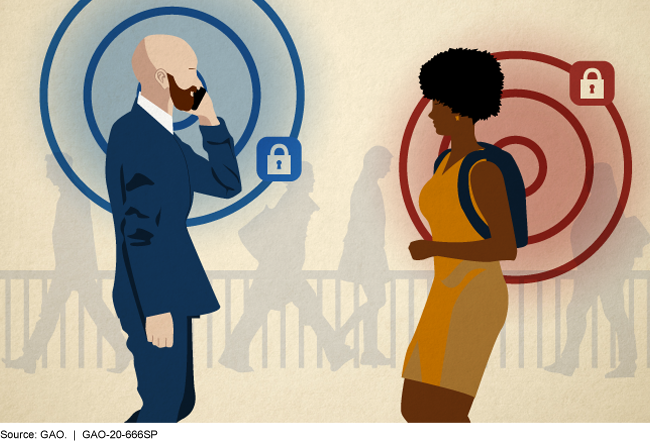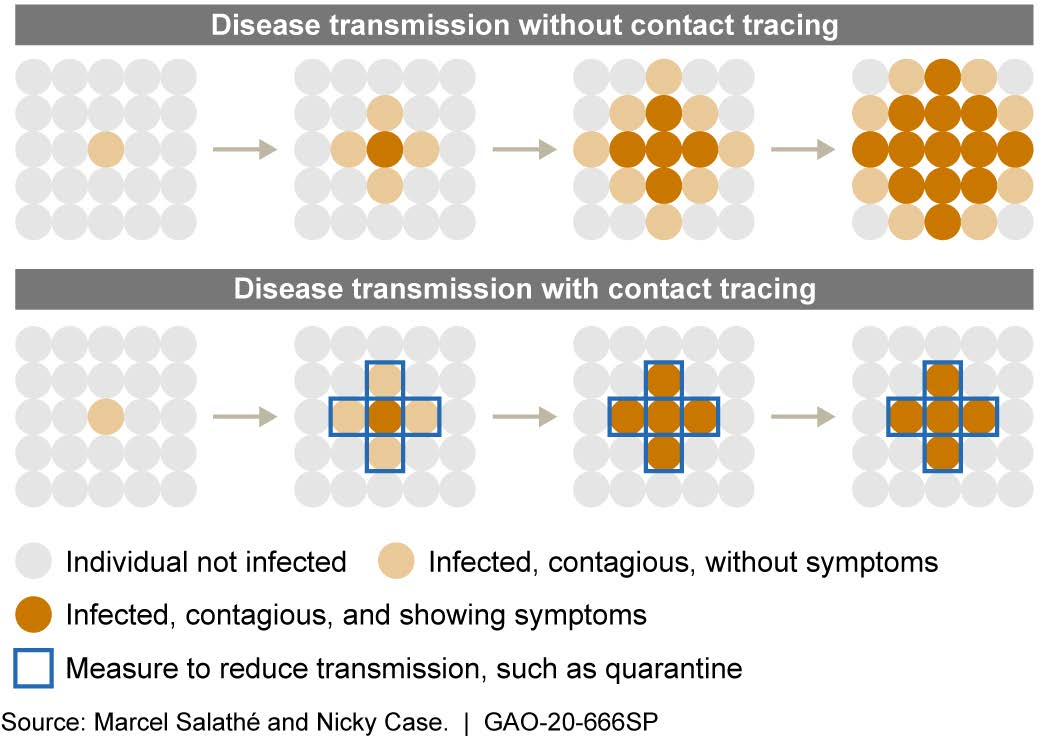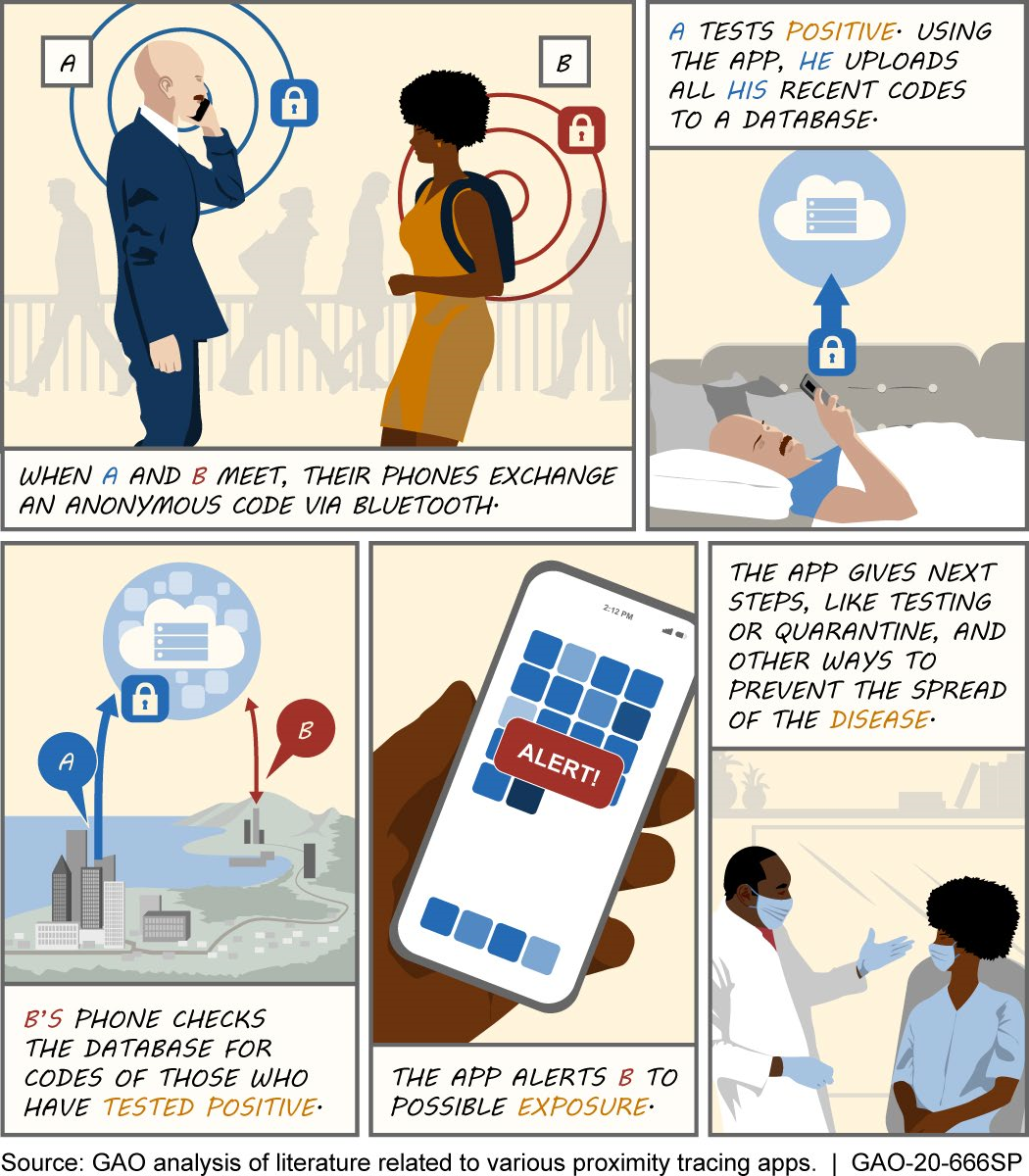Science & Tech Spotlight: Contact Tracing Apps
Fast Facts
Contact tracing apps are a relatively new technology that can help reduce transmission rates for infectious diseases like COVID-19. Using smartphones, the apps rapidly identify and notify people who may have been near an infected person and possibly exposed.
Contact tracing apps may reach more people than traditional contact tracing, which uses public health officials to identify and notify those potentially exposed.
As policymakers consider whether to adopt the use of contact tracing apps, they will need to weigh the benefits with potential challenges, such as accuracy of the technology, adoption rates, and privacy concerns.
Illustration of contact tracing apps exchanging signals

Highlights
Why This Matters
Contact tracing can help reduce transmission rates for infectious diseases like COVID-19 by identifying and notifying people who may have been exposed. Contact tracing apps, notably those using proximity tracing, could expedite such efforts. However, there are challenges, including accuracy, adoption rates, and privacy concerns.
The Technology
What is it? Contact tracing is a process in which public health officials attempt to limit disease transmission by identifying infected individuals, notifying their "contacts"—all the people they may have transmitted the disease to—and asking infected individuals and their contacts to quarantine, if appropriate (see fig. 1). For a highly contagious respiratory disease such as COVID-19, a contact could be anyone who has been nearby. Proximity tracing applications (apps) can expedite contact tracing, using smartphones to rapidly identify and notify contacts.

Figure 1. A simplified depiction of disease transmission. Through contact tracing, an infected individual’s contacts are notified and may be asked to quarantine. (In reality, some contacts may not become infected, and some of those infected may not show symptoms.)
How does it work? In traditional contact tracing, public health officials begin by identifying an infected individual. They then interview the individual to identify recent contacts, ask the individual and their contacts to take containment measures, if appropriate (e.g., a 14-day quarantine for COVID-19), and coordinate any needed care and testing. Proximity tracing apps may accelerate the process by replacing the time-consuming interviews needed to identify contacts. Apps may also identify more contacts than interviews, which rely on interviewees' recall and on their being acquainted with their contacts.
Public health authorities provide the apps, often using systems developed by companies or research groups. Users voluntarily download the app for their country or region and opt in to contact tracing. In the U.S., state or local public health authorities would likely implement proximity tracing apps.
Proximity tracing apps detect contacts using Bluetooth, GPS, or a combination of both. Bluetooth-based apps rely on anonymous codes shared between smartphones during close encounters. These codes contain no information about location or user identity, helping safeguard privacy. The apps allow public health authorities to set a minimum time and distance threshold for someone to count as a contact.
Contact tracing can be centralized or decentralized. With a centralized approach, contacts identified by the app are often saved to a government server, and an official notifies contacts of possible exposure. For a decentralized approach, contact data are typically stored on the user's device at first. When a user voluntarily reports infection, the user's codes are uploaded to a database that other app users' phones search. Users who have encountered the infected person then receive notifications through the app (see fig. 2).

Figure 2. Bluetooth-based proximity tracing apps exchange information, notify contacts exposed to an infected person, and provide follow-up information.
How mature is it? Traditional contact tracing is well established and has been an effective infectious disease response strategy for decades. Proximity tracing apps are relatively new and not as well established. Their contact identifications could become more accurate as developers improve app technology, for example by improving Bluetooth signal interpretation or using information from other phone sensors.
Opportunities
- Reach more people. For accurate COVID-19 contact tracing using traditional methods, public health experts have estimated that the U.S. would require hundreds of thousands of trained contact tracers because of the large number of infections. Proximity tracing apps can expedite and automate identification and notification of the contacts, reducing this need.
- Faster response. Proximity tracing apps could slow the spread of disease more effectively because they can identify and notify contacts as soon as a user reports they are infected.
- More complete identification of contacts. Proximity tracing apps, unlike traditional contact tracing, do not require users to recall or be acquainted with people they have recently encountered.
Challenges
- Technology. Technological limitations may lead to missed contacts or false identification of contacts. For example, GPS-based apps may not identify precise locations, and Bluetooth apps may ignore barriers preventing exposure, such as walls or protective equipment. In addition, apps may overlook exposure if two people were not in close enough proximity long enough for it to count as a contact.
- Adoption. Lower adoption rates make the apps less effective. In the U.S., some states may choose not to use proximity tracing apps. In addition, the public may hesitate to opt in because of concerns about privacy and uncertainty as to how the data may be used. Recent scams using fake contact tracing to steal information may also erode trust in the apps.
- Interoperability. Divergent app designs may lead to the inability to exchange data between apps, states, and countries, which could be a problem as travel restrictions are relaxed.
- Access. Proximity tracing apps require regular access to smartphones and knowledge about how to install and use apps. Some vulnerable populations, including seniors, are less likely to own smartphones and use apps, possibly affecting adoption.
Policy Context and Questions
Although proximity tracing apps are relatively new, they have the potential to help slow disease transmission. But policymakers will need to consider how great the benefits are likely to be, given the challenges. If policymakers decide to use proximity tracing apps, they will need to integrate them into the larger public health response and consider the following questions, among others:
- What steps can policymakers take to build public trust and encourage communities to support and use proximity tracing apps, and mitigate lack of adoption by some populations?
- What legal, procedural, privacy, security, and technical safeguards could protect data collected through proximity tracing apps?
- What can policymakers do to improve coordination of contact tracing efforts across local, state, and international jurisdictions?
- What can policymakers do to expedite testing and communication of test results to maximize the benefits of proximity tracing apps?
- What can policymakers do to ensure that contact identification is accurate and that its criteria are based on scientific evidence?
For more information, contact Karen Howard at (202) 512-6888 or HowardK@gao.gov.
